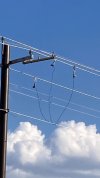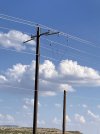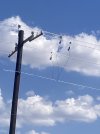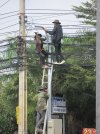You are using an out of date browser. It may not display this or other websites correctly.
You should upgrade or use an alternative browser.
You should upgrade or use an alternative browser.
[Overhead wires]
- Thread starter Let'sgoflying!
- Start date
They're not... note the insulators. I suspect the "wires" hanging down aren't conductive, either. I think what you're seeing is the rig that lets a lineman hang from the wire and move along it to inspect the line between the poles. Or rather, three of them, clipped together when not in use.
midwestpa24
En-Route
- Joined
- Mar 4, 2016
- Messages
- 4,994
- Display Name
Display name:
midwestpa24
I can't see the photos well enough to make it out, but it looks similar to a ground. If so, linemen will ground the live wires of a section that is offline for maintenance to prevent an accidental electrical shock.
Note <this guy is not lineman, electrician, nor has stayed at a Holiday Inn Express and his opinion should not be used. Electrical shock hazard!
Note <this guy is not lineman, electrician, nor has stayed at a Holiday Inn Express and his opinion should not be used. Electrical shock hazard!
Half Fast
Touchdown! Greaser!
Hard to tell from the pics. Possibly lightning surge arresters?
There are only three things I've ever been afraid of: electricity, height, and women.
Half Fast
Touchdown! Greaser!
There are only three things I've ever been afraid of: electricity, height, and women.
So a tall woman electrician would be instant death?
DreadPirateWill
Filing Flight Plan
- Joined
- Dec 23, 2020
- Messages
- 15
- Display Name
Display name:
DreadPirateWill
They're shorted/grounded for safety during installation. When we reconductor a line it's pretty typical to put hot arms on(the fiberglass arms attached to the normal crossarm) and spread the phase wires out then using pulling ropes to run the tag line then new conductor down the center. The outside phase wires in that picture if you look close are live to keep customers energized. Looks like it's also part of a larger rebuild from wood to fiberglass poles, the joint use should come in later and attach to the new pole and pull the old wood.
Let'sgoflying!
Touchdown! Greaser!
Ok thanks!
I will confirm tonight (late tonight), pretty sure my ladder, on the bed of my pickup can reach.
I’ll take the vom up with me, let you know the readings.
Isnt electricity fun?
I will confirm tonight (late tonight), pretty sure my ladder, on the bed of my pickup can reach.
I’ll take the vom up with me, let you know the readings.
Isnt electricity fun?
DreadPirateWill
Filing Flight Plan
- Joined
- Dec 23, 2020
- Messages
- 15
- Display Name
Display name:
DreadPirateWill
Out of an odd sense of obligation, I'll indicate I'm quite sure this is sarcasm as getting near power lines is a way to die, but not a particularly good way to die. Most VOM are good to 600 or so volts, good chance this line is 7200V to ground. It would be exciting for a few milliseconds, then all your neighbors would come to pee on your grave for interrupting Matlock.Ok thanks!
I will confirm tonight (late tonight), pretty sure my ladder, on the bed of my pickup can reach.
I’ll take the vom up with me, let you know the readings.
Isnt electricity fun?
To paraphrase a country song: electricity is fun, beer is good, and people are crazy.
SoonerAviator
Final Approach
- Joined
- Jul 21, 2014
- Messages
- 9,361
- Location
- Broken Arrow, OK
- Display Name
Display name:
SoonerAviator
Out of an odd sense of obligation, I'll indicate I'm quite sure this is sarcasm as getting near power lines is a way to die, but not a particularly good way to die. Most VOM are good to 600 or so volts, good chance this line is 7200V to ground. It would be exciting for a few milliseconds, then all your neighbors would come to pee on your grave for interrupting Matlock.
To paraphrase a country song: electricity is fun, beer is good, and people are crazy.
If you look closely, you will see 3 large, and 3 small conductors on insulators.
The old small ones are still carrying power to the customers, the new larger ones are grounded, as the line work is not yet complete.
When the new conductors are all properly installed, they will be energized, load transferred, and the old wires will be de energized, grounded, and removed.
Finally, the new wires will be transferred to the original insulators on the central cross arm, and the cross arm extensions will be removed.
This procedure is definitely not a lineman's favorite work day.
The Geezer's work at the power company included only a few "Flights" in a bucket, but High Ranger's were included. No fun on a gusty day, 60 feet up, and leaning way out of the bucket.
The old small ones are still carrying power to the customers, the new larger ones are grounded, as the line work is not yet complete.
When the new conductors are all properly installed, they will be energized, load transferred, and the old wires will be de energized, grounded, and removed.
Finally, the new wires will be transferred to the original insulators on the central cross arm, and the cross arm extensions will be removed.
This procedure is definitely not a lineman's favorite work day.
The Geezer's work at the power company included only a few "Flights" in a bucket, but High Ranger's were included. No fun on a gusty day, 60 feet up, and leaning way out of the bucket.
Let'sgoflying!
Touchdown! Greaser!
As midwestpa said.
and....thanks!
They are working on new poles a ways from here.
The way the lines are draped all over each other and everything I doubt they are energized.
I understand they may carry other forms of dangerous current however; maybe induced?
Here is a better photo. I was immediately across from it and zoomed in.
Everyone knows with the new poa software you have to click the photos to see the detail? At least this is something I noticed.
and....thanks!
They are working on new poles a ways from here.
The way the lines are draped all over each other and everything I doubt they are energized.
I understand they may carry other forms of dangerous current however; maybe induced?
Here is a better photo. I was immediately across from it and zoomed in.
Everyone knows with the new poa software you have to click the photos to see the detail? At least this is something I noticed.
Attachments
Let'sgoflying!
Touchdown! Greaser!
Daleandee
Final Approach
- Joined
- Mar 4, 2020
- Messages
- 6,324
- Display Name
Display name:
Dale Andee
That ain't me ...Safety First!

So a tall woman electrician would be instant death?
DreadPirateWill
Filing Flight Plan
- Joined
- Dec 23, 2020
- Messages
- 15
- Display Name
Display name:
DreadPirateWill
Green arrows are de-energized, reds are most likely hot. The near phase that's out on the hot arm is tougher to see.
You can certainly get induced current on a line, especially if it parallels another energized line for a long ways. Most distribution lines it tends not to be a problem, can get pretty spicy on long transmission lines.
There's really only one type of current, but a line can be energized by any number of things - grid as normal, capacitive coupling, inadvertent contact, backfeed from an improperly installed residential backup generator, etc. That's why shorts and grounds are installed where linemen are working - keep the humans from being a path to ground.
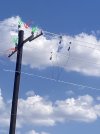
You can certainly get induced current on a line, especially if it parallels another energized line for a long ways. Most distribution lines it tends not to be a problem, can get pretty spicy on long transmission lines.
There's really only one type of current, but a line can be energized by any number of things - grid as normal, capacitive coupling, inadvertent contact, backfeed from an improperly installed residential backup generator, etc. That's why shorts and grounds are installed where linemen are working - keep the humans from being a path to ground.

PaulS
Touchdown! Greaser!
Don't screw around near power lines, period.... or even joke about it due to dumb people thinking it might be ok.
I just had my house painted, my painter was telling me about painting a larger building in an urban area that had 3 phase coming into it. The building inspector saw them working with ladders and a couple lifts near (he said about 25 feet away from) the lines. The inspector flipped out and gave them a cease work order. They had to call the electric company who made them schedule line men to shut down the lines while they painted. They had 2 hours to get that part done. The painter said he had no clue at the time that the lines, were high voltage and an arc could have easily killed them.
I just had my house painted, my painter was telling me about painting a larger building in an urban area that had 3 phase coming into it. The building inspector saw them working with ladders and a couple lifts near (he said about 25 feet away from) the lines. The inspector flipped out and gave them a cease work order. They had to call the electric company who made them schedule line men to shut down the lines while they painted. They had 2 hours to get that part done. The painter said he had no clue at the time that the lines, were high voltage and an arc could have easily killed them.
Let'sgoflying!
Touchdown! Greaser!
Any idea what amps is running through that?
enough to cook a human to medium-well?
Let'sgoflying!
Touchdown! Greaser!
I was farther down that road today, interested to note this bonding was repeated about every 1000’ for a mile, maybe two.
Let'sgoflying!
Touchdown! Greaser!
I’m so respectful/skeered of flying electrons I won’t hardly even go near a pole without good reason.
midwestpa24
En-Route
- Joined
- Mar 4, 2016
- Messages
- 4,994
- Display Name
Display name:
midwestpa24
Don't amps go down when volts go up? So if those were high voltage primary lines, what would the volts and amps be? Just curious.Any idea what amps is running through that?
Llewtrah381
Line Up and Wait
- Joined
- Apr 9, 2010
- Messages
- 999
- Display Name
Display name:
Llewtrah
I’ve seen them around here (Austin area) and wondered the exact same thing. There are plenty of them and not just on lines being upgraded - but not on every line.I was farther down that road today, interested to note this bonding was repeated about every 1000’ for a mile, maybe two.
I kinda wonder if it’s a Texas thing for some reason.
MauleSkinner
Touchdown! Greaser!
My wife is Polish, so I don’t have a choice.I’m so respectful/skeered of flying electrons I won’t hardly even go near a pole without good reason.
DreadPirateWill
Filing Flight Plan
- Joined
- Dec 23, 2020
- Messages
- 15
- Display Name
Display name:
DreadPirateWill
Without knowing the load downstream, not really. Can't really tell conductor size from the picture either but as a semi educated guess looks like reconductoring from somewhere around #2 to #2/0, up to 336-556ish. Old small wire ampacity would be 180-280 or so, usually sized to carry 40-100 for loss reasons. 556 is good for 600A, it's a typical trunk line for feeder ties.Any idea what amps is running through that?
For a given power flow, if voltage goes up amps go down. Tough to tell from the insulators, this is either 15 or 25kv class so if it was carrying 20 amps that's 450 or 900kw roughly.
You'll see the shorts/grounds on a project like this at intervals because the line personnel need to see a visible set from any given work location. One thing that looks similar is a riser for an underground feed, looks like similar attachments at the phases but insulated and feeds cable.
SoonerAviator
Final Approach
- Joined
- Jul 21, 2014
- Messages
- 9,361
- Location
- Broken Arrow, OK
- Display Name
Display name:
SoonerAviator
So THAT's how to keep your daughter off the pole. Make her scared of electricity!I’m so respectful/skeered of flying electrons I won’t hardly even go near a pole without good reason.

